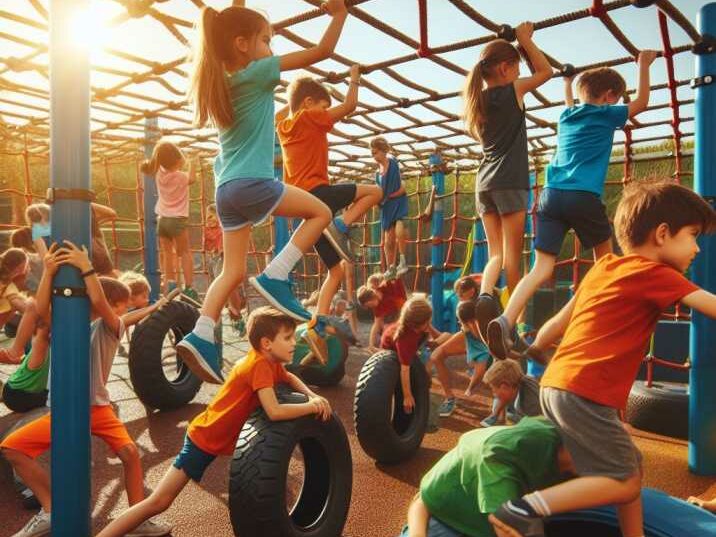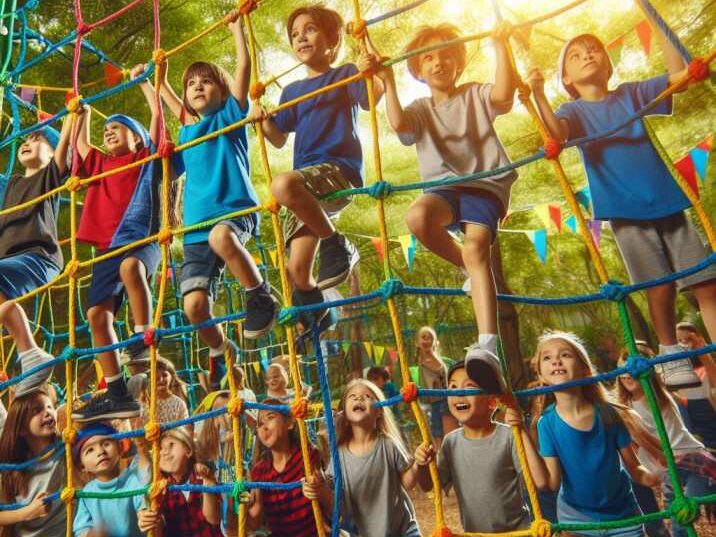Benefits of Kids Obstacle Course
Table of Contents
Introduction:
In the whirlwind of modern childhood, where screens dominate and outdoor activities wane, the quest for cultivating vital skills in children remains paramount. In this article, we delve into the fascinating world of “Obstacle Course Training for Developing Quick Reflexes in Children.” This holistic approach not only promises physical prowess but also nurtures cognitive abilities. Join us on this journey as we explore the benefits, methods, and science behind this transformative training.
The Essence of Obstacle Course Training:
Children are inherently wired for movement, exploration, and challenge. Obstacle course training taps into these natural instincts, offering a structured yet fun environment for kids to navigate. The combination of hurdles, balance beams, and climbing structures not only builds physical strength but also sharpens reflexes. As they conquer obstacles, children develop resilience, problem-solving skills, and the ability to think on their feet.
Why Choose Obstacle Course Training?
Holistic Development: Obstacle course training engages multiple senses and motor skills simultaneously, fostering a holistic approach to development. From agility to coordination, every aspect is honed in this dynamic setting.
Fun and Engagement: Unlike traditional exercises, obstacle courses inject an element of play, making the training sessions enjoyable for children. This not only ensures consistent participation but also establishes a positive attitude towards physical activity.
Cognitive Benefits: Research indicates a strong connection between physical activity and cognitive development in children. Obstacle course training, with its varied challenges, enhances spatial awareness, decision-making, and problem-solving abilities.

The Science Behind Quick Reflexes:
Obstacle course training induces a unique form of adaptive stress on the body and mind. As children navigate through hurdles and make split-second decisions, their brains receive signals to enhance reflexes. This adaptive stress triggers the release of neurotransmitters, contributing to improved reaction times.
Structuring an Effective Obstacle Course:
Creating a successful obstacle course involves thoughtful planning. Here’s a guide to crafting an engaging and effective setup:
Variety of Challenges: Incorporate a mix of challenges, including climbing, crawling, balancing, and jumping. This diversity ensures comprehensive development.
Age-Appropriate Elements: Tailor the obstacles to the age group, ensuring they are challenging yet safe. Adjustable elements allow for ongoing progression.
Team Building Opportunities: Include elements that encourage teamwork. Collaborative efforts not only make the course more enjoyable but also foster social skills.

The Role of Parents and Instructors:
While obstacle course training can be enjoyed in various settings, the role of parents and instructors is pivotal. Their encouragement, guidance, and active participation create a positive atmosphere that maximizes the benefits of the training.
Conclusion:
In conclusion, “Obstacle Course Training for Developing Quick Reflexes in Children” emerges as a holistic and enjoyable approach to child development. Beyond the physical benefits, this dynamic training method shapes resilient, confident, and quick-thinking individuals. As parents, educators, and guardians, embracing this engaging journey can unlock the full potential of our children.

FAQs
- Q: What age group is suitable for obstacle course training? A: Obstacle course training can be adapted for various age groups, starting as early as preschool age.
- Q: Are there safety concerns with obstacle course training for children? A: Safety is paramount. Ensure age-appropriate elements and adequate supervision to minimize risks.
- Q: How often should children engage in obstacle course training? A: Consistency is key. Aim for 2-3 sessions per week, adjusting intensity based on age and fitness levels.
- Q: Can obstacle course training be adapted for children with varying fitness levels? A: Absolutely. Obstacle courses can be tailored to accommodate different fitness levels, ensuring that each child is appropriately challenged and experiences progression over time.
- Q: Are there specific safety measures parents should consider when setting up an obstacle course at home? A: Safety is paramount. Parents should ensure a soft landing surface, secure equipment, and supervise children closely. Padding and helmets may be necessary for certain elements.
- Q: How does obstacle course training contribute to emotional development in children? A: Negotiating obstacles fosters resilience and confidence. Overcoming challenges in a supportive environment promotes emotional well-being and a positive self-image.
- Q: Can children with special needs benefit from obstacle course training? A: Yes, obstacle courses can be adapted to cater to children with special needs. Consultation with professionals can help customize the course to suit individual requirements.
- Q: Is there evidence supporting the claim that obstacle course training improves academic performance in children? A: Research suggests a link between physical activity and cognitive function. While not a direct guarantee, obstacle course training can positively influence focus, memory, and academic engagement.
- Q: How can obstacle course training contribute to social development in children? A: Team-based challenges within obstacle courses encourage cooperation, communication, and teamwork, fostering valuable social skills and camaraderie among participants.
- Q: Can obstacle course training be done indoors, or does it require an outdoor setting? A: Both options are viable. Indoor obstacle courses can be designed with soft play equipment, while outdoor courses benefit from natural elements. The key is adaptability and creativity.
- Q: What role does positive reinforcement play in maximizing the benefits of obstacle course training? A: Positive reinforcement enhances motivation and enjoyment. Praise and encouragement during and after completing challenges contribute to a child’s sense of accomplishment.
- Q: How long does it take to see noticeable improvements in a child’s reflexes through obstacle course training? A: Improvement timelines vary, but regular participation, usually over several weeks, is key. Consistency in training sessions allows for the gradual development of reflexes and other skills.
- Q: Can parents incorporate educational elements into obstacle course training for added cognitive benefits? A: Absolutely. Parents can integrate educational challenges into the course, such as solving puzzles or answering questions at specific stations, enhancing the cognitive benefits of the training.
- Q: Are there specific warm-up and cool-down routines recommended before and after obstacle course training? A: Yes, warm-up activities should include light stretching and aerobic exercises. Cool-down routines can involve gentle stretching and relaxation exercises to prevent injury and promote flexibility.


